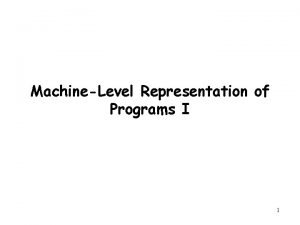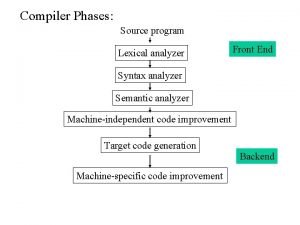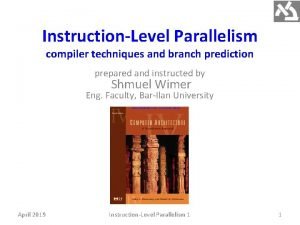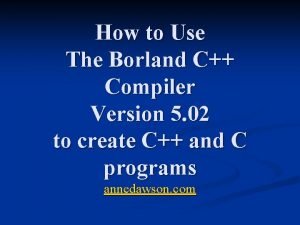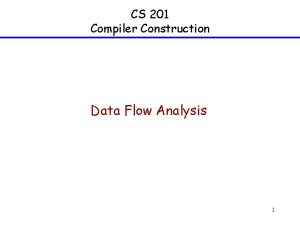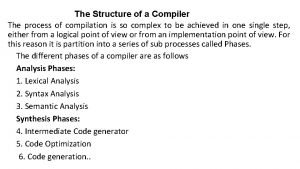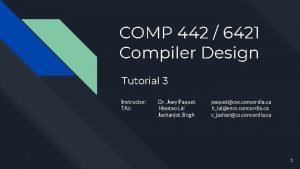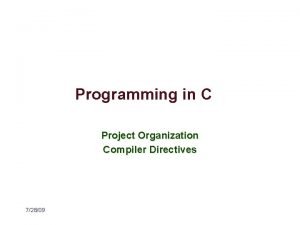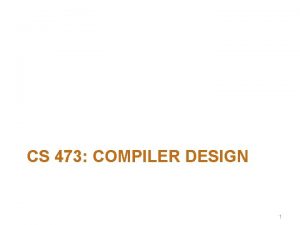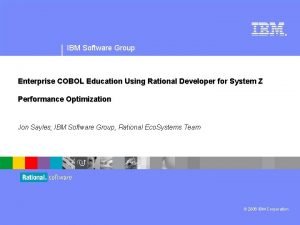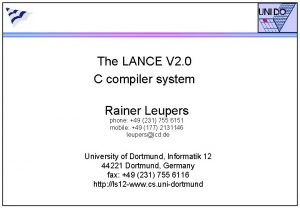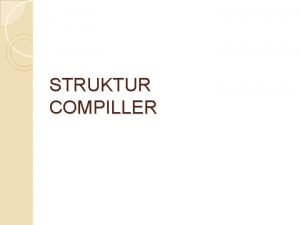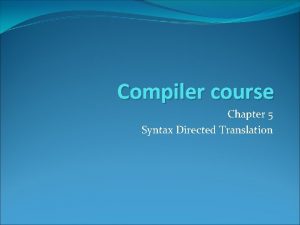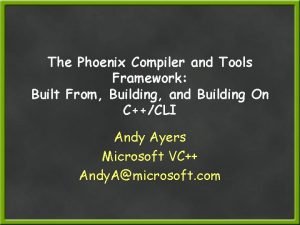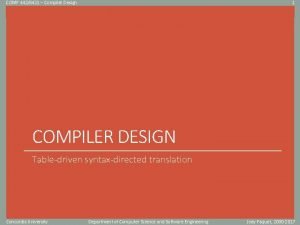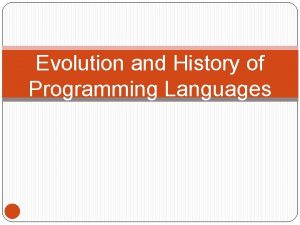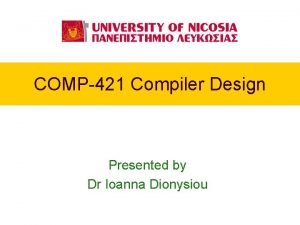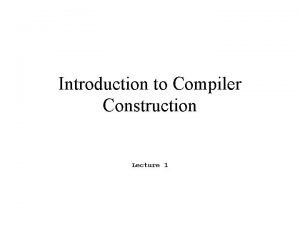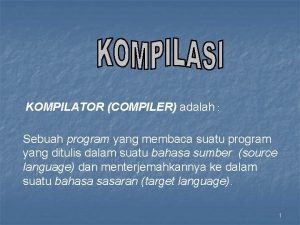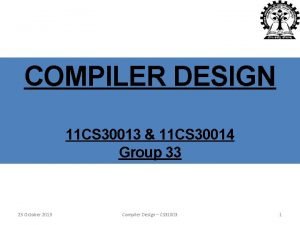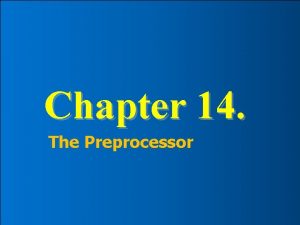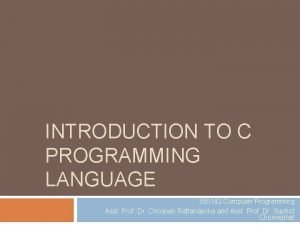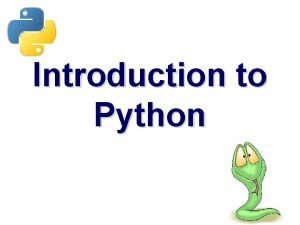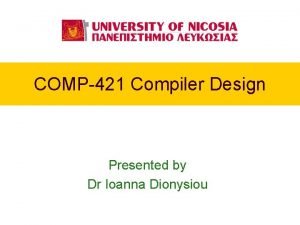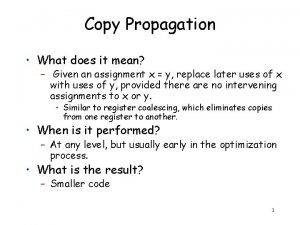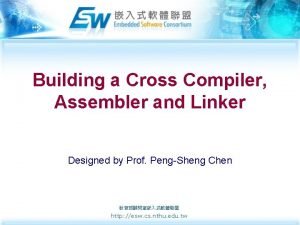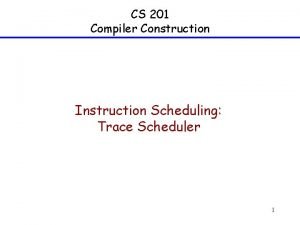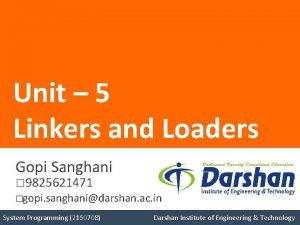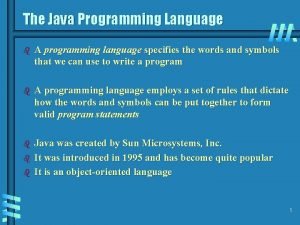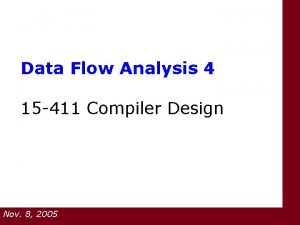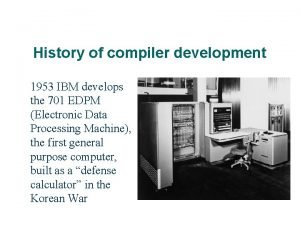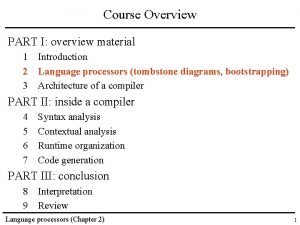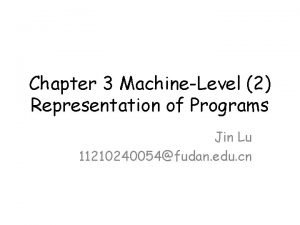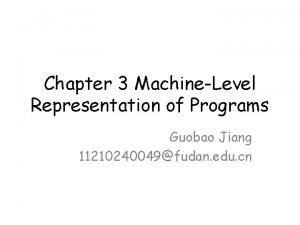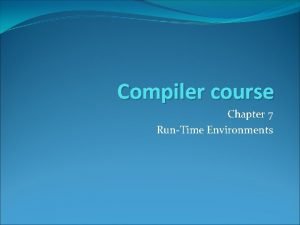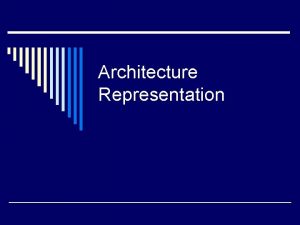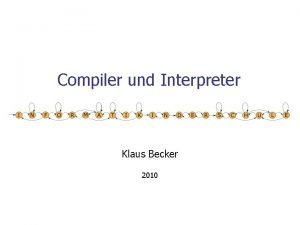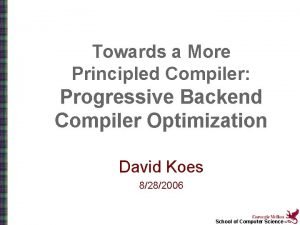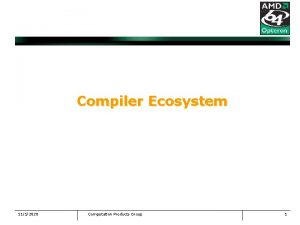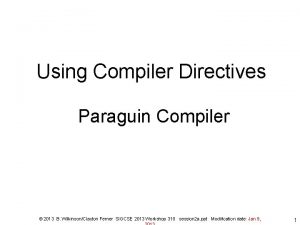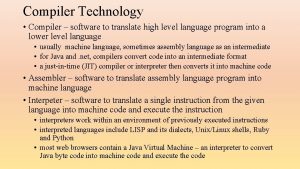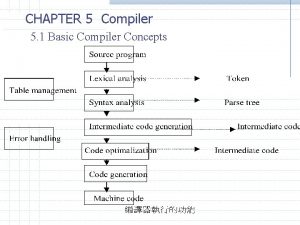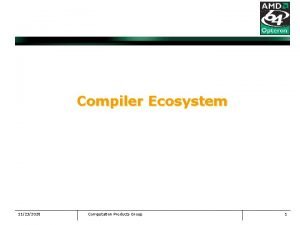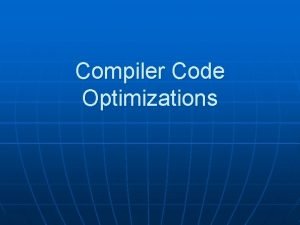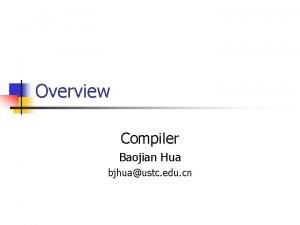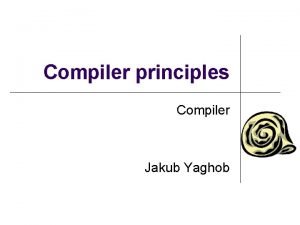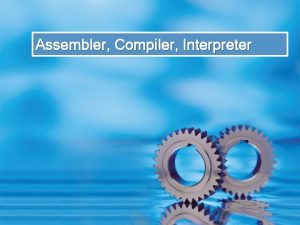MachineLevel Representation of Programs I 1 Outline Compiler











































- Slides: 43

Machine-Level Representation of Programs I 1

Outline • • • Compiler drivers History of the Intel IA-32 architecture Assembly code and object code Memory and Registers Addressing Mode Data Formats • Suggested reading – Chap 1. 2, 1. 4. 1, 1. 7. 3, 3. 1, 3. 2, 3. 3, 3. 4. 1 2

The Hello Program • It begins life as a high-level C program – Can be read and understand by human beings • The individual C statements must be translated by compiler drivers – So that the hello program can run on a computer system – Compiler:编译器 3

The Hello Program • The C programs are translated into – A sequence of low-level machine-language instructions • These instructions are then packaged in a form – called an object program • Object program are stored as a binary disk file – Also referred to as executable object files 4

The Context of a Compiler (gcc) Figure 1. 3 P 5 hello. c Source program (text) Preprocessor (cpp) hello. i Modified source program (text) Compiler (cc 1) hello. s Assembly program (text) Assembler (as) hello. o Relocatable object program (binary) Linker (ld) Compiler: 编译器 Assembler: 汇编器 Linker: 连接器 hello Executable object program (binary) 5

Characteristics of the high level programming languages • Abstraction – Productive – reliable • Type checking • As efficient as hand written code • Can be compiled and executed on a number of different machines, whereas assembly code is highly machine specific Productive:多产的 Reliable: 可靠的 6

Characteristics of the assembly programming languages • Managing memory • Low level instructions to carry out the computation • Highly machine specific 7

Why should we understand the assembly code • Understand the optimization capabilities of the compiler • Analyze the underlying inefficiencies in the code • Sometimes the run-time behavior of a program is needed 8

From writing assembly code to understand assembly code • Different set of skills – Transformations – Relation between source code and assembly code • Reverse engineering – Trying to understand the process by which a system was created • By studying the system and • By working backward Backward: 回溯 9

A Historical Perspective • Long evolutionary development – Started from rather primitive 16 -bit processors – Added more features • Take the advantage of the technology improvements • Satisfy the demands for higher performance and for supporting more advanced operating systems – Laden with features providing backward compatibility that are obsolete * laden with: 承载 * compatibility: 兼容性 * obsolete: 陈旧的 10

X 86 family • 8086(1978, 29 K) – The heart of the IBM PC & DOS – 1 M bytes addressable, 640 K for users • 80286(1982, 134 K) – More (now obsolete) addressing modes – Basis of the IBM PC-AT & Windows 11

X 86 family • i 386(1985, 275 K) – 32 bits architecture, flat addressing model – Support a Unix operating system • I 486(1989, 1. 9 M) – Integrated the floating-point unit onto the processor chip 12

X 86 family • Pentium(1993, 3. 1 M) • Pentium. Pro(1995, 6. 5 M) – P 6 microarchitecture – Conditional mov • Pentium/MMX(1997, 4. 5 M) – New class of instructions for manipulating vectors of integers 13

X 86 family • Pentium II(1997, 7 M) – Implementing MMX instructions within P 6 • Pentium III(1999, 8. 2 M) – New class of instructions for manipulating vectors of floating-point numbers(SSE, Stream SIMD Extension) 14

X 86 family • Pentium 4(2001, 42 M) – Netburst microarchitecture – 144 new SSE 2 instructions 15

X 86 family • Advanced Micro Devices (AMD) – Now are close competitors to Intel – Developing own extension to 64 -bits 16

X 86 family • Transmeta – In January of 2002, introduced Crucoe. TM processor – Radically different approach to implementation • Translates x 86 code into “Very Long Instruction Word” (VLIW) code • High degree of parallelism – Shooting for low-power market such as lap-top computers 17

Hardware Organization • CPU: Central Processing Unit • ALU: Arithmetic/Logic Unit • PC: Program Counter • USB: Universal Serial Bus Figure 1. 4 P 7 18

Virtual spaces • A linear array of bytes – each with its own unique address (array index) starting at zero 0 xfffffffe contents addresses … … 0 x 2 0 x 1 0 x 0 19

Data layout • Object model in C – Different data types can be declared 20

Data layout • Object model in assembly – A large, byte-addressable array – No distinctions even between signed or unsigned integers – Code, user data, OS data – Run-time stack for managing procedure call and return – Blocks of memory allocated by user 21

• Figure 1. 13 22 P 17

Operations in C constructs • Arithmetic expression evaluation • Loops • Procedure calls and returns • Translated into sequences of instructions 23

Operations in Assembly Instructions • Performs only a very elementary operation • Normally one by one in sequential • Operate data stored in registers • Transfer data between memory and a register • Conditionally branch to a new instruction address 24

Assembly Programmer’s View Figure 3. 2 P 136 %eax %ah %al %edx %dh %dl %ecx %ch %cl %ebx %bh %bl Addresses Data FF C 0 BF Stack %esi %edi Instructions 80 7 F %esp %ebp %eip %eflag 40 3 F 08 00 Heap DLLs Heap Data Text 25

Programmer-Visible States P 129 • Program Counter(%eip) – Address of the next instruction • Register File – Heavily used program data – Integer and floating-point 26

Programmer-Visible States • Conditional code register – Hold status information about the most recently executed instruction – Implement conditional changes in the control flow 27

Code Examples P 130 C code int sum(int x, int y) { int t = x+y; return t; } Obtain with command _sum: pushl %ebp movl %esp, %ebp movl 12(%ebp), %eax addl 8(%ebp), %eax movl %ebp, %esp popl %ebp ret gcc –O 2 -S code. c Assembly file code. s 28

Code Examples P 131 55 89 e 5 8 b 45 0 c 03 45 08 01 05 00 00 89 ec 5 d c 3 Obtain with command gcc –O 2 -c code. c Relocatable object file code. o 29

Code Examples Obtain with command objdump -d code. o Disassembly output (P 132 反汇编输出) 0 x 80483 b 4 <sum>: 0 x 80483 b 4 55 0 x 80483 b 5 89 e 5 0 x 80483 b 7 8 b 45 0 c 0 x 80483 ba 03 45 08 0 x 80483 bd 01 05 00 00 0 x 80483 c 3 89 ec 0 x 80483 c 5 5 d 0 x 80483 c 6 c 3 push mov add pop ret nop %ebp %esp, %ebp 0 xc(%ebp), %eax 0 x 8(%ebp), %eax %ebp, %esp %eax, 0 x 0 %ebp 30

C Code • Add two signed integers • int t = x+y; 31

Assembly Code • Operands: – x: – y: – t: Register Memory Register %eax M[%ebp+8] %eax • Instruction – addl 8(%ebp), %eax – Add 2 4 -byte integers – Similar to expression x +=y • Return function value in %eax 32

Object Code • 3 -byte instruction • Stored at address 0 x 80483 b 7 • 0 x 80483 b 7: 03 45 08 33

Operands P 137 • In high level languages – Either constants (常数) – Or variable (变量) – A=A+4 va ri ab le • Example constant 34

Operands • Counterparts in assembly languages – Immediate ( constant ) – Register ( variable ) – Memory ( variable ) memory • Example movl 8(%ebp), %eax register addl $4, %eax immediate 35

Simple Addressing Mode • Immediate – represents a constant – The format is $imm ($4, $0 xffff) • Registers – The fastest storage units in computer systems – Typically 32 -bit long – Register mode Ea • The value stored in the register • Noted as R[Ea] 36

Virtual spaces • A linear array of bytes – each with its own unique address (array index) starting at zero 0 xfffffffe contents addresses … … 0 x 2 0 x 1 0 x 0 37

Memory References • The name of the array is annotated as M • If addr is a memory address • M[addr] is the content of the memory starting at addr • addr is used as an array index • How many bytes are there in M[addr]? – It depends on the context 38

Memory Addressing Mode • An expression for – a memory address (or an array index) • Most general form – imm (Eb, Ei, s) – s: 1, 2, 4, 8 • The address represented by the above form – imm + R[Eb] + R[Ei] * s • It gives the value – M[imm + R[Eb] + R[Ei] * s] 39

Addressing Mode Type Form Figure 3. 3 P 137 Operand value Name Immediate $Imm Immediate Register Ea R[Ea] Register Memory Imm M[Imm] Absolute Memory (Ea) M[R[Ea]] Indirect Memory Imm(Eb) M[Imm+ R[Eb]] Base+displacement Memory (Eb, Ei) M[R[Eb]+ R[Ei]] Indexed Memory Imm(Eb, Ei) M[Imm+ R[Eb]+ R[Ei]] Scaled indexed Memory (, Ei, s) M[R[Ei]*s] Scaled indexed Memory (Eb, Ei, s) M[R[Eb]+ R[Ei]*s] Scaled indexed Memory Imm(Eb, Ei, s) M[Imm+ R[Eb]+ R[Ei]*s] Scaled indexed 40

Address 0 x 100 Value 0 x. FF 0 x 104 0 x. AB 0 x 108 0 x 13 0 x 10 C 0 x 11 Operand Register %eax %ecx %edx Value 0 x 100 0 x 1 0 x 3 • Practice problem 3. 1 P 138 Value Comment %eax 0 x 100 Register (%eax) 0 x. FF Address 0 x 100 $0 x 108 0 x 13 260(%ecx, %edx) 0 x 13 Address 0 x 108 (%eax, %edx, 4) 0 x 11 Address 0 x 10 C 41 Immediate Absolute address

Data Formats Figure 3. 1 P 135 C declaration Intel data type char short int unsigned long char * float double long double Byte Word Double word Double word Single precision Double precision Extended precision GAS suffix b w l l l s l t Size (byte) 1 2 4 4 4 8 10/12 42

Data Formats • Move data instruction – – mov (general) movb (move byte) movw (move word) movl (move double word) 43
 Lex yacc example
Lex yacc example Cross compiler in compiler design
Cross compiler in compiler design Disadvantages of waterfall model in software engineering
Disadvantages of waterfall model in software engineering Machine level representation of data
Machine level representation of data Sandwich quotes examples
Sandwich quotes examples Compiler phases
Compiler phases Compiler techniques for exposing ilp
Compiler techniques for exposing ilp Borland compiler
Borland compiler Very busy
Very busy Structure of a compiler
Structure of a compiler Trace based collection in compiler design
Trace based collection in compiler design Compiler design tutorial
Compiler design tutorial Organization of compiler
Organization of compiler Induction variable elimination in compiler design
Induction variable elimination in compiler design Ssrange in cobol example
Ssrange in cobol example Compiler
Compiler Active oberon
Active oberon Lance compiler
Lance compiler Struktur compiler
Struktur compiler Applications of syntax-directed translation
Applications of syntax-directed translation Phoenix compiler
Phoenix compiler Compiler
Compiler 3rd generation programming language
3rd generation programming language Codeplay compiler
Codeplay compiler Transition diagram in compiler design
Transition diagram in compiler design Compiler lecture
Compiler lecture Modelon コンパイラ
Modelon コンパイラ Complier adalah:
Complier adalah: Applications of sdd in compiler design
Applications of sdd in compiler design Compiler control directives in c
Compiler control directives in c The designer expresses the ideas in terms related to the
The designer expresses the ideas in terms related to the Assembler
Assembler 350142
350142 History of python
History of python Source language issues in compiler design
Source language issues in compiler design What is copy propagation
What is copy propagation Gnu gcc is a: cross compiler assembler linker loader
Gnu gcc is a: cross compiler assembler linker loader Trace scheduling
Trace scheduling Reloctab
Reloctab Java interpreter
Java interpreter Introduction to compiler construction
Introduction to compiler construction Constant propagation in compiler design
Constant propagation in compiler design Cousins of compiler
Cousins of compiler Difference between assembler and compiler
Difference between assembler and compiler



